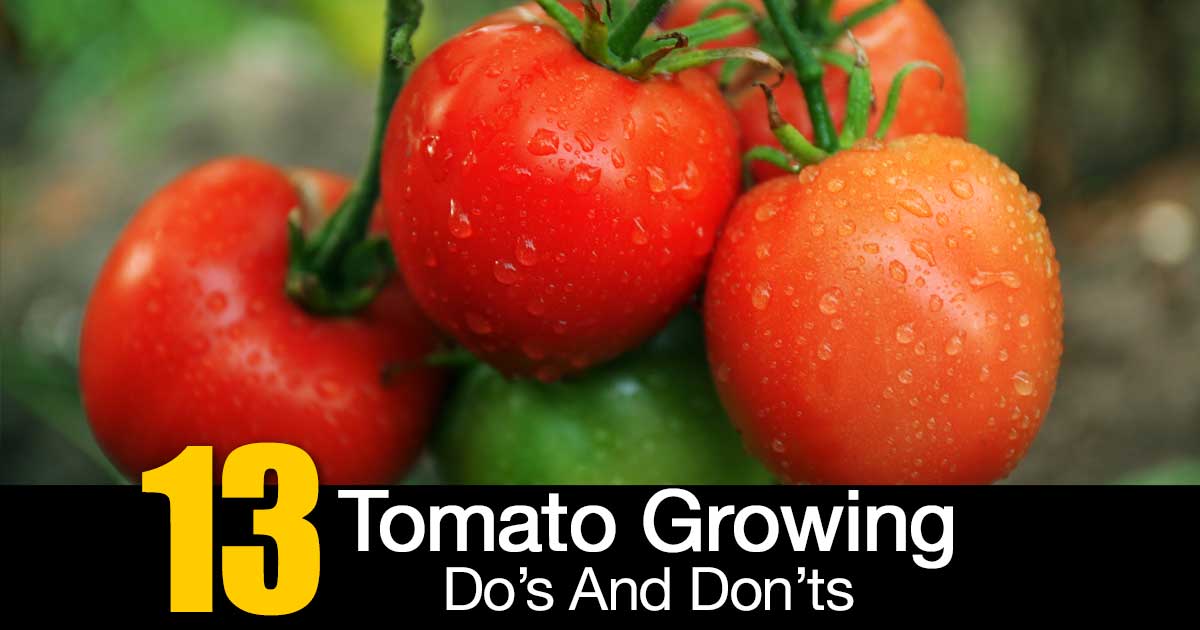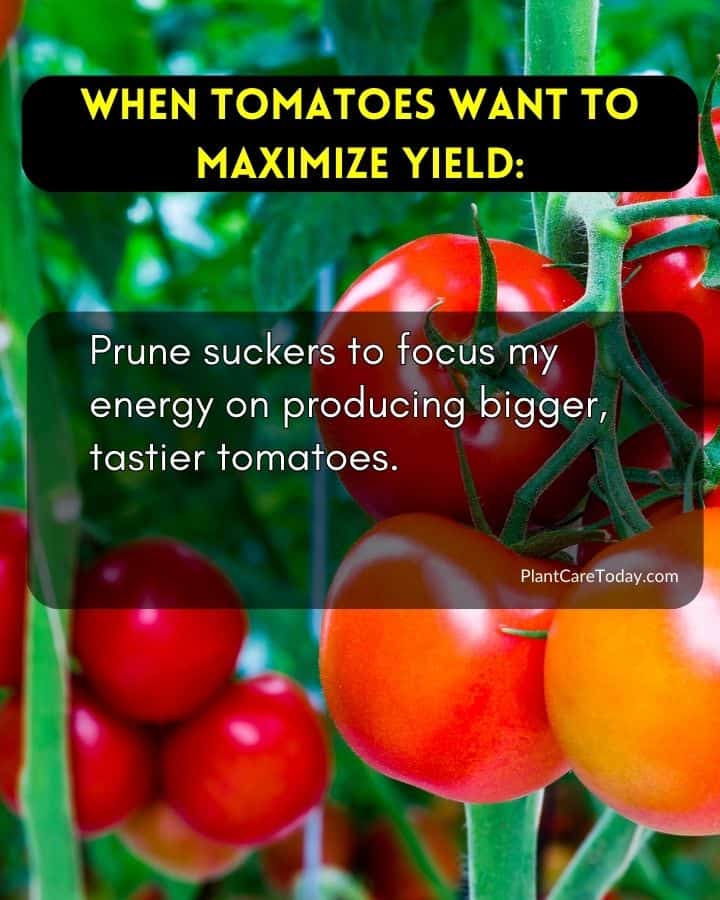Looking for tips on tomato plant care? Over time, we all learn tips and tricks that help us during the growing season to produce more vegetables and color our gardens, the landscape, and even the lawns.
Little things like don’t plant unless the soil is above X degrees. Tomato plants have their “tricks,” which help produce high-yield crops of tomatoes.

Here are some do’s and don’ts about caring for tomato plants.
Growing Tomato Plants – 8 Do’s and 5 Don’ts.
Don’t
Buy seedlings of tomato plants that are already flowering. You might believe you’ll be one step ahead.

But… tomato plants first need to establish their roots in the potting soil before flowering and producing fruits. Let them start and flower in your garden.
Do

When growing tomato plants – pinch the flowers of the future first fruits on budding plants. It might sound ridiculous, but you’ll get greater yields by pruning tomato plants in the long run.

Don’t
Over-fertilize your crops of tomato plants. The majority of people think that by adding more slow-release fertilizer, a plant grows faster, and you’ll double or increase yields in the same proportion.
Too much nitrogen fertilizer in the soil will lead to more foliage and wonderful bushes. The tomato plants will look healthy but unproductive.
It is also one of the reasons for blossom end rot.
To enrich your soil, use more soil compost, not additional water-soluble fertilizer. The same applies to your peppers.
Do
Add a bit of Epsom salt for tomatoes to do well. When Epsom salt is added to their roots, and if they don’t need it, it will cause no harm. It’s good to take preventive measures to ensure healthier tomato plants.
Do
When starting tomato plants from seed and it is time to transplant (late spring or early summer), plant your seedlings several inches deep with the tops sticking out. It’s often called “Planting up to their necks.”

This enables tomato plants to grow a strong root system. The better the roots and root system, the more yields you’ll get because your growing tomatoes will get more nutrients and water intake.
Learn more about Tomato Plant Growth!
Don’t
If possible, water your tomatoes from the above. Watering them from below will cause the soil to splash up on the stems, making them susceptible to tomato plant diseases.
Use a dripping system or soaker hose whenever you want to water your tomatoes and maintain soil moisture.
Related: How To Deep Water Tomato Plants
Do
Mulch your tomatoes, especially when you’re using an overhead irrigation system.
This will help prevent the soil from splashing on the tomato stems and keep the garden soil around the tomato plant moist.
Do

Stake your tomato plants. Tomato cages are a popular and easy way to increase yield, reduce disease, and make caring for them easier.
Do
Know the type of tomatoes you’re growing. Understand that planting the “determinate type” of tomatoes might stop producing fruits suddenly.

Also, know the type of plants you will plant along with tomatoes. Great companion plants for tomatoes include jalapeno pepper, nasturtiums, calendula, carrots, basil, and more.
Don’t Stress When You Harvest Tomatoes
Don’t stress over having too many tomatoes! Do you have tomatoes in plenty, or are you concerned about the fruit flies invading your kitchen because of the influx of tomatoes?
Simply wash a good number and store them in the freezer. Defrost them after some time. You’ll see the tomato’s skin slipping off.
Do
Plant several tomato varieties if you have ample space for them; Plum and Roma’s tomatoes are the best varieties for preserving and slicing for fresh eating.

On the other hand, Beefmaster tomatoes are an indeterminate plant belonging to the low-maintenance tomato variety.
Cherry tomatoes are ideal for snacking. I love the “ugly” tomato for putting on a sandwich. Plant your tomatoes, knowing the intention of your planting.
Don’t Plant One Tomato
Don’t transplant one tomato plant from its containers to the outside world before the soil temperature hits 50° degrees Fahrenheit.

The soil temperature is determined by how close the sun is, the amount of sunshine the area receives, and the depth of the sun’s warmth.
The soil’s surface can feel warm, but 6″ inches from the surface still feels cold. You can plant the tomatoes when the overnight lows are reliably above 50° degrees Fahrenheit.
It will still work, but it’s best to wait until the soil temperature is above 50° degrees Fahrenheit and plant your tomatoes in direct sunlight.
Do
Speed the growing and maturing of your tomatoes by covering the soil area with black plastic and tilling the soil around often.

If you plant early in the season, keep the tomatoes warm by using cloches. Canning jars can still keep plants warm on cool evenings.
But don’t let the plants get fried by the heat. These containers can only be used when the fruits are still young and green.
Do
Protect your tomatoes from different tomato pests, such as the tomato hornworm caterpillar, tomato frog, tomato fruitworm, leaf-footed bug, stink bug, and more. Check your tomatoes regularly to make sure they are not infested.
Related: Does Neem Oil Control Tomato Hornworms
Keeping leaves and fruit off the ground will also protect them from tomato plant diseases such as tomato rot, late blight, fusarium wilt, and more by proper watering and the use of organic tomato fertilizers.
Learn more about treating Late Blight on Tomatoes.
